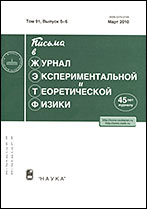|
This article is cited in 5 scientific papers (total in 5 papers)
DISCUSSION
Kinetic model of softening of glasses
V. V. Brazhkin
Institute for High Pressure Physics, Russian Academy of Sciences, Troitsk, Moscow, 108840 Russia
Abstract:
A liquid-glass transition (vitrification) has been analyzed in terms of the softening of a solid phase through diffusion jumps. It has been shown that the assumption of a Gibbs momentum distribution (in fact, local thermalization) in glass automatically results in the existence of diffusion in glasses at any temperatures. In view of this conclusion, the possibility of a virtual “thermodynamic” transition responsible for vitrification is questionable. A model of jumps of “hot” particles has been proposed that predicts the existence of two characteristic temperatures $T_A$ and $T_B$ and describes qualitative changes in the temperature dependence of the viscosity of a liquid upon cooling (“Arrhenius”–“super-Arrhenius”–“Arrhenius”). The temperatures $T_A$ and $T_B$ are related to the number of particles in the first coordination sphere and the number of particles in the region of structural correlations (intermediate order region) in disordered media. The concept of ergodicity is discussed in application to glasses.
Received: 07.10.2020
Revised: 29.10.2020
Accepted: 02.11.2020
Citation:
V. V. Brazhkin, “Kinetic model of softening of glasses”, Pis'ma v Zh. Èksper. Teoret. Fiz., 112:11 (2020), 787–793; JETP Letters, 112:11 (2020), 745–751
Linking options:
https://www.mathnet.ru/eng/jetpl6320 https://www.mathnet.ru/eng/jetpl/v112/i11/p787
|


| Statistics & downloads: |
| Abstract page: | 163 | | Full-text PDF : | 34 | | References: | 36 | | First page: | 10 |
|





 Contact us:
Contact us: Terms of Use
Terms of Use
 Registration to the website
Registration to the website Logotypes
Logotypes







 Citation in format
Citation in format 
